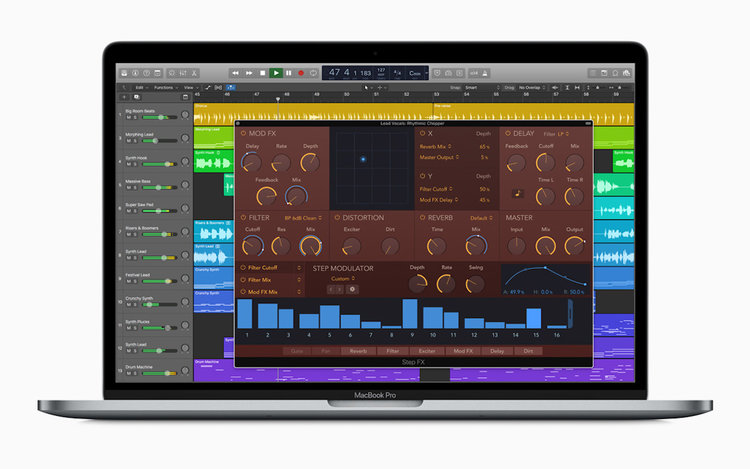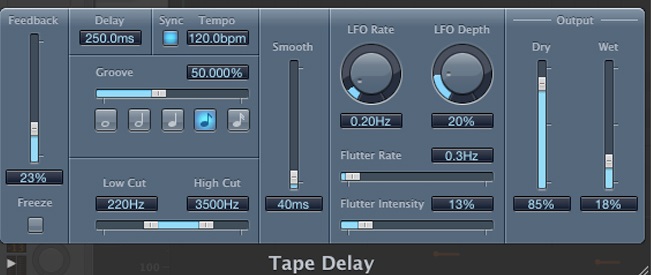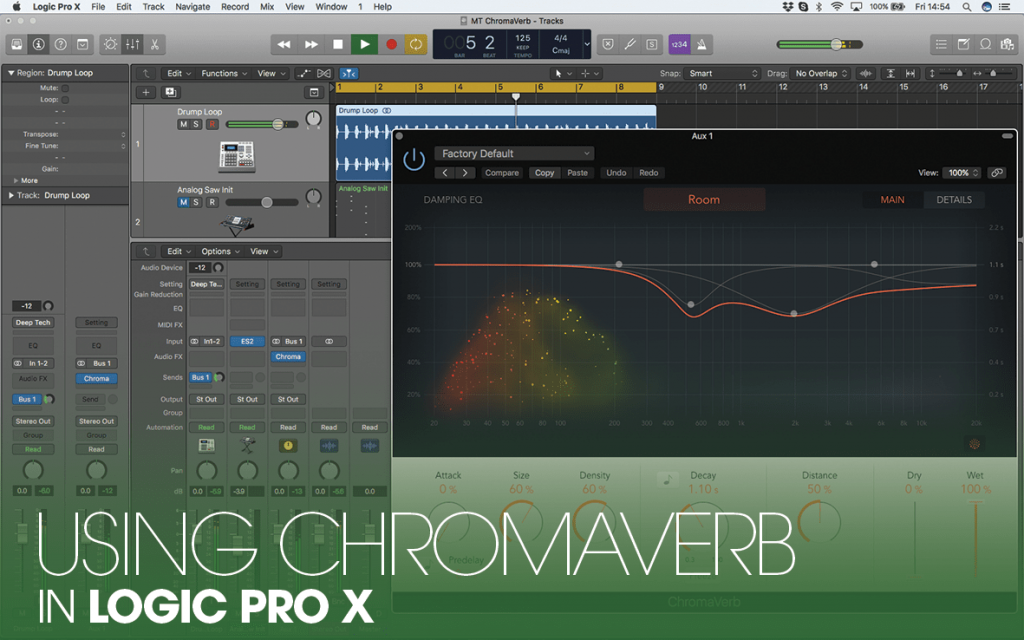Logic reverb. Logic Pro X Tutorial 2019-01-13
Logic Pro X Tutorial

You know the problem — those 'S' sounds hit the reverb like Indiana Jones' worst nightmare! This isn't the only problem, though, because what also happens is that the almost instantaneous early reflections of a reverb without pre-delay interact unpredictably with the dry sound in a way that can noticeably alter its tone. This plugin reverb offers extreme flexibility and astonishing quality of sound. Exploiting the full potential of Space Designer, therefore, is a tangible way to improve the quality of your mixes. Which left and right channels are you referring to? But, have you considered going with a real spring reverb either built in to an old 'live' board, or pushing stuff through a guitar amp w reverb and taking the signal out of the effects loop jacks. I can probably compare the Kurzweils too since I have one of those. We'll start by adding some reverb on the lead vocal track. The particular pattern of the Early Reflections determines the overall character of the reverb; further reflections build up into a dense field of later reverberation that eventually dies away.
Logic Pro X Tutorial: Reverb & Space Designer

Channel your inner rock star and reach for when you want something special on that mix. After recording and during mixing, when turned to the left, the pan knob on a stereo interleaved track decreases the level of the right mic and when turned to the right it decreases the level of the left - it acts purely as a balance knob. The source feels closer, with the reverb floating ethereally in the background This tutorial is endorsed by Point Blank. You might also like to check and ProducerSpot. The four specific effects that I've described here are designed to be fairly all-purpose in this way, and can be used in tandem to tie together mixes in a variety of different styles. Beyond that rather intangible decision, though, there are a few other more down-to-earth things to consider.
Adding reverb and delay to your mix

In this move lets see how to use sends to set up this mixed type of processing. Unassign the output of the duplicate track, so that it doesn't directly influence your vocal mix level. Erm, yeah, that's another downside. With modern commercial styles I almost always cut away some of the low frequencies with a high-pass filter set somewhere in the 100-300Hz range, simply because it allows me to keep the required focus and punch of kick drums and bass lines uncompromised. But whatever reverb you use, you must remember to set the reverb to 100% wet, with no dry signal whatsoever. On the second Details page there are more interesting options. The second reverb can then be set to give much more of a sense of an acoustic space, using a longer and perhaps slightly brighter reverb as required, but combining that with a fairly long pre-delay maybe 30-70ms , to avoid the effect distancing sounds that it's applied to very much further.
Logic Pro X Tutorial: Reverb & Space Designer

It's worth pointing out that the Reverb1 file also veers off to one side of the stereo image as it decays, which isn't ideal either. Going beyond the typical early and late reflections calculations of most algorithmic reverbs, this one includes an additional cluster parameter that determines what happens between the early reflections and conventional reverb tail. Here's how you do it. This simulates sitting at the back of a hall and hearing the sound from the stage almost at the same time as the echo from the back wall. Now you can send from the Duplicate track to your reverb and set its return level to taste. We are focused on member experience here on the page and the goal here makes it easier for vendors to participate without all the barriers and confusion while at the same time allowing members to easily seek out or ignore threads that are promotional in nature.
Logic's reverb plugins : Logic_Studio

Piracy is not tolerated on this subreddit. After tracking, I set the individual levels and the pan of both tracks how I like it, then in the channel strip of each, I'll send them to bus 1, for example and set up the reverb there. I also often cut high frequencies as well, either with a low-pass filter or high shelf. First of all, let's start by looking at how you can use just reverb to draw a final mix together, and then we'll build on that to show the subtly different possibilities that are afforded by delay effects. The choice of reverb is up to you. Moving deeper into the program, Scott explains how to work with music notation and score to video. The next most common thing I do with any reverb is adjust its tonality to suit the track.
10 Best Free Reverb VST/AU Plugins

For this reason, the primary objective of reverbs and delays is to reconnect tracks that have no inherent connection by giving them some shared acoustic characteristics, and it's this task that's the subject of the article at hand. Yes, there are all of the standard effects like equalization, compression, reverb and delay included in the Logic Pro X plugins arsenal. Support requests are fine, but the scope of the subreddit is everything relevant to Logic Pro and its related software. The final reverb parameter that I regularly reach for is the pre-delay setting, which simply delays the onset of the reverb reflections by a specified amount — the longer the pre-delay, the closer the dry sounds appear to be in comparison with the boundaries of the simulated room. Another interesting quality in the reverb is relative density, which distinguishes between the reverb heard as a series of discrete echoes, or a more cohesive tail.
Adding reverb and delay to your mix

In Logic, you can record audio into a single stereo track with two mics or into two seperate mono audio tracks - one for the left and one for the right mic respectively. As its been said, there's more than enough presets there really. Lisc-Verb is very flexibility in controlling the input signal and to combine reverb and delay signal to create space and depth effects. Can anyone offer any advice on where to find some good spring verbs or even get more out of Logic than just the Vintage Reverbs in Space Designer?. I agree with the previous post… Quantum Leap Spaces is my go to 1 reverb.
Logic Pro 9

The only problem we have now, is that in Logic Pro X, there is no way to turn off software input monitoring for a track while you are recording to it, unless you turn off software monitoring entirely, which would prevent us from setting up the reverb. Note that this is not the input gain, which is set via a physical knob on the front of the 18i20 audio interface. The DualReverbsDry file, as you might expect, is the same section without any reverb at all, just for reference. Insert a Compressor plug-in into the Buss object after whatever delay plug-in you've chosen. Then Mariah Carey came in for a session in 2013.
The 10 Best Reverb Plugins In The World 2017

Filters are typically employed to further shape the tonal character of the reverb, and all these adjustable parameters can be saved into various presets, which can either emulate the sound of real rooms and halls and mimic the unique quality of older mechanical reverb devices like plates and springs, or be tweaked for less-natural special effects like reverb pads and swirling soundscapes. Create a send to the buss from the vocal Track object by selecting from its drop-down Sends menu. Check out the and stay tuned for a new installment each week in 2017. So I can mix in just a bit of reverb or room sound controlled by the send level. Expectations of time constraints for help are unreasonable.
Logic Pro X Reverb Shootout: ChromaVerb vs Space Designer : orgmode.com

I used to love the spring reverb in my mixing board, before it stopped working. If you have a listen to the ReverbLength audio files you can hear how the length of a single reverb can affect the fullness of the mix, given a fixed effect-return level. Match Making Matching the reverb to the source material usually starts by exploring the size of the virtual room, or to put it another way, the length of the reverb tail. Cheers Hey tuned in, thanks for the comments — yeah, there definitely is a shortage of good-sounding spring reverb plugins around. As the last section of the workshop illustrates, Space Designer can turn its hand to interesting and unusual sound-design treatments — ranging from drone-like resonators, to ghostly tempo-synced echo effects. Like David above, I almost always set it up into a bus and have the left and right channels feeding the bus.